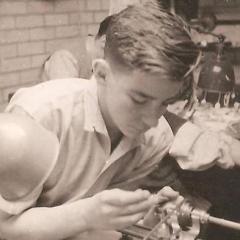Tips on removal, cleaning and reinstalation of fiddly cab jewels
-
Recently Browsing
- No registered users viewing this page.
-
Topics
-
Posts
-
I've found with Russian watches they don't stick to the Swiss numbering system. The problem with the mainspring is that as this is a dual barrel system they're very small compared to most automatics. If you look on Cousins the weakest 1.45mm high spring is 0.085mm which could be too powerful for this movement and is also designed for a 7.5mm barrel. If you then look at the GR Catalogue and work back from the GR3930X, this is the first auto with correct power rating. Although you'd probably have to go back further to this one to make sure it fits.
-
By TimepieceTinkerer · Posted
Hi all, I’m currently working on an ETA 2836-2 movement. I replaced the pallet fork with a new one (ETA2801710, sourced from CousinsUK). After full reassembly and lubrication, I’ve encountered a strange issue: The movement is fully wound and has power. When I fit the balance assembly, the movement does not tick at all—completely dead. When I remove the balance, the gear train suddenly releases and spins freely, indicating power was present. The pallet fork just “floats” without snapping side to side—almost as if it isn’t even there. No interaction with the escape wheel is visible at that point. However: Before fitting the balance, I checked the pallet fork manually — it was working as it should, clearly interacting with the escape wheel. I’ve inspected the pallet bridge jewel (where the pallet fork sits) and everything looks normal. No signs of misalignment or obstruction. I’ve rechecked everything I can think of and I’m completely out of ideas. Has anyone seen this behaviour before? Any suggestions would be greatly appreciated. Thanks in advance! TT -
Thanks for the prompt response. I apologise for not stating the issue more clearly. The problem is that - what I now know I should have called - the centre wheel is not being turned by the pinion (which is driven by the barrel) with which it shares the arbour (1st photo above). The pinion & arbour are indeed reverse threaded but the arbour (the 'screw') is clearly damaged ('rounded' rather than 'sharp' threads) with swarf evident. When the pinion is screwed on there is only enough connection to prevent the pinion being lifted off but not enough to stop it turning on the arbour. Is a (reversible) repair (threadlocker?) possible in the short term while a replacement centre wheel assembly is sought so that the viability otherwise of the watch can be established?
-
Sorry this is a bit late but how did it go for you? I'm working on a 561 with a similar issue. Cheers, Martin
-
I'm struggling to put it back so I'm going to watch a tutorial so may be a few hours.
-






Recommended Posts